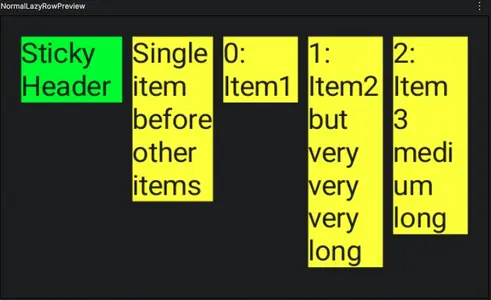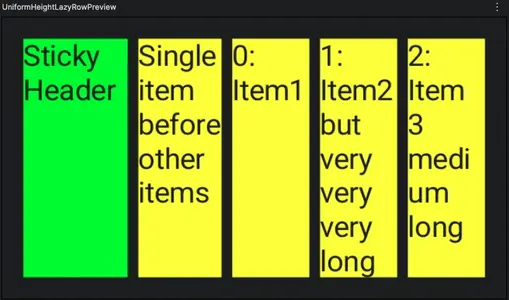What would you do if you needed a LazyRow where all items are forced to have the same height?
There’s no perfect solution, as enforcing uniform height means every item must be measured—negating the performance benefits of using a LazyRow in the first place.
But if you’re aware of the trade-offs, we can aim for a solution that’s readable, maintainable, and “lazy enough” for many use cases.
Option 1: A Row with a custom SnapLayoutInfoProvider
This works well when all items have the same width.
For example, this implementation provides snapping behavior similar to that of a LazyRow.
However, supporting items with varying widths would require a custom LazyListLayoutInfo to track each item’s index and size.
At that point, you’re essentially re-implementing LazyRow from scratch—which is hard to justify in terms of maintainability.
Option2: A semi-custom LazyRow
What if we mimicked LazyRow’s measurement pass, calculated the maximum height of all items up front, and then used that to set the row’s height?
Yes, this breaks the “lazy” aspect, but we’ll keep calling it UniformHeightLazyRow for simplicity.
Here’s what a standard LazyRow looks like:
1
2
3
4
5
6
7
8
9
10
11
12
13
14
15
16
17
18
19
20
21
22
23
24
25
26
27
28
29
30
31
32
33
34
35
36
|
@Preview
@Composable
private fun NormalLazyRowPreview() {
Theme {
val items = persistentListOf("Item1", "Item2 but very very very long", "Item 3 medium long")
LazyRow(
contentPadding = PaddingValues(10.dp),
horizontalArrangement = Arrangement.spacedBy(5.dp),
) {
stickyHeader {
Text(
modifier = Modifier
.width(50.dp)
.background(Color.Green),
text = "Sticky Header",
)
}
item {
Text(
modifier = Modifier
.background(Color.Yellow)
.width(40.dp),
text = "Single item before other items",
)
}
itemsIndexed(items) { index, item ->
Text(
modifier = Modifier
.background(Color.Yellow)
.fillParentMaxWidth(0.1f),
text = "$index: $item",
)
}
}
}
}
|
Modifier.fillParentMaxHeight() only has an effect when the LazyRow has a fixed height, which is not the case here.

Capturing Items via Custom Scope
LazyRow uses LazyListScope to define its content:
1
2
3
4
5
|
@Composable
fun LazyRow(
...
content: LazyListScope.() -> Unit
)
|
1
2
3
4
5
6
7
8
9
10
11
12
13
14
15
16
17
18
19
20
21
22
23
|
interface LazyListScope {
// Adds a single item.
fun item(
key: Any? = null,
contentType: Any? = null,
content: @Composable LazyItemScope.() -> Unit
)
// Adds a [count] of items.
fun items(
count: Int,
key: ((index: Int) -> Any)? = null,
contentType: (index: Int) -> Any? = { null },
itemContent: @Composable LazyItemScope.(index: Int) -> Unit
)
// Adds a sticky header item
fun stickyHeader(
key: Any? = null,
contentType: Any? = null,
content: @Composable LazyItemScope.() -> Unit
)
}
|
To build our version, we need a similar interface—except our item content will also accept a Modifier parameter that we’ll use later to enforce height.
Here’s the core of UniformHeightLazyListScope:
1
2
3
4
5
6
7
8
9
10
11
12
13
14
15
16
17
18
19
20
21
22
23
24
25
26
27
28
29
30
31
32
33
34
35
36
37
38
39
40
41
42
43
44
45
46
47
48
49
50
51
52
53
|
class UniformHeightLazyListScope {
data class ItemEntry(
val key: Any?,
val contentType: Any?,
val content: @Composable LazyItemScope.(Modifier) -> Unit,
)
// Accumulate each item in the order they're added
val items = mutableListOf<ItemEntry>()
var stickyHeader: ItemEntry? = null
fun item(
key: Any? = null,
contentType: Any? = null,
content: @Composable LazyItemScope.(Modifier) -> Unit,
) {
items += ItemEntry(key, contentType, content)
}
fun items(
count: Int,
key: ((index: Int) -> Any)? = null,
contentType: (index: Int) -> Any? = { null },
itemContent: @Composable LazyItemScope.(index: Int, modifier: Modifier) -> Unit,
) {
repeat(count) { index ->
items += ItemEntry(key?.invoke(index), contentType.invoke(index)) { modifier ->
itemContent(index, modifier)
}
}
}
inline fun <T> itemsIndexed(
items: List<T>,
noinline key: ((index: Int, item: T) -> Any)? = null,
crossinline contentType: (index: Int, item: T) -> Any? = { _, _ -> null },
crossinline itemContent: @Composable LazyItemScope.(index: Int, modifier: Modifier, item: T) -> Unit,
) = items(
count = items.size,
key = if (key != null) { index: Int -> key(index, items[index]) } else null,
contentType = { index -> contentType(index, items[index]) },
) { index, modifier ->
itemContent(index, modifier, items[index])
}
fun stickyHeader(
key: Any? = null,
contentType: Any? = null,
content: @Composable LazyItemScope.(Modifier) -> Unit,
) {
stickyHeader = ItemEntry(key, contentType, content)
}
}
|
We now define a UniformHeightLazyRow with the same parameters as a normal LazyRow, but with a custom content scope.
1
2
3
4
5
6
7
8
9
10
11
12
13
|
@Composable
fun UniformHeightLazyRow(
modifier: Modifier = Modifier,
state: LazyListState = rememberLazyListState(),
contentPadding: PaddingValues = PaddingValues(0.dp),
reverseLayout: Boolean = false,
horizontalArrangement: Arrangement.Horizontal =
if (!reverseLayout) Arrangement.Start else Arrangement.End,
verticalAlignment: Alignment.Vertical = Alignment.Top,
flingBehavior: FlingBehavior = ScrollableDefaults.flingBehavior(),
userScrollEnabled: Boolean = true,
content: UniformHeightLazyListScope.() -> Unit,
)
|
Using SubcomposeLayout, we render the contents once just to measure their heights, identify the tallest one, and apply that height to the final LazyRow.
Here’s how we measure the height:
1
2
3
4
5
6
7
8
9
10
11
12
13
14
15
16
17
18
19
20
21
22
23
24
25
26
27
28
29
30
31
32
33
34
35
|
val density = LocalDensity.current
val layoutDirection = LocalLayoutDirection.current
SubcomposeLayout(modifier) { constraints ->
val leftPadPx = with(density) { contentPadding.calculateLeftPadding(layoutDirection).toPx() }
val rightPadPx = with(density) { contentPadding.calculateRightPadding(layoutDirection).toPx() }
val totalHorizontalPaddingPx = leftPadPx + rightPadPx
val topPadPx = with(density) { contentPadding.calculateTopPadding().toPx() }
val bottomPadPx = with(density) { contentPadding.calculateBottomPadding().toPx() }
val totalVerticalPaddingPx = topPadPx + bottomPadPx
val capturingScope = UniformHeightLazyListScope()
capturingScope.content()
// Measure children as if they have (maxWidth - padding) available
val measureMaxWidth = (constraints.maxWidth - totalHorizontalPaddingPx).coerceAtLeast(0f).toInt()
val itemConstraints = constraints.copy(
maxWidth = measureMaxWidth,
minWidth = 0,
)
val placeables = subcompose("preMeasure") {
lazyItemScope ???
capturingScope.stickyHeader?.content?.invoke(lazyItemScope, Modifier)
for ((_, _, itemContent) in capturingScope.items) {
itemContent(lazyItemScope, Modifier)
}
}.map { measurable ->
measurable.measure(itemConstraints)
}
// Find the tallest
val maxHeightPx = placeables.maxOfOrNull { it.height } ?: constraints.minHeight
val maxHeightDp = with(density) { maxHeightPx.toDp() + totalVerticalPaddingPx.toDp() }
...
}
|
Ah, an instance of LazyItemScope needs to be passed to the items. Let’s do a quick implementation of it.
Since we explicitly measure and enforce the row’s height, fillParentMaxHeight can be ignored.
Similarly, fillParentMaxSize will only affect width.
1
2
3
4
5
|
private class UniformHeightLazyItemScope : LazyItemScope {
override fun Modifier.fillParentMaxHeight(fraction: Float): Modifier = this
override fun Modifier.fillParentMaxSize(fraction: Float): Modifier = this.fillMaxWidth(fraction)
override fun Modifier.fillParentMaxWidth(fraction: Float): Modifier = this.fillMaxWidth(fraction)
}
|
Let’s repeat the previous code with a working instance of LazyItemScope:
1
2
3
4
5
6
7
8
9
10
11
12
13
14
15
16
17
18
19
20
21
22
23
24
25
26
27
28
29
30
31
32
33
34
35
|
val density = LocalDensity.current
val layoutDirection = LocalLayoutDirection.current
SubcomposeLayout(modifier) { constraints ->
val leftPadPx = with(density) { contentPadding.calculateLeftPadding(layoutDirection).toPx() }
val rightPadPx = with(density) { contentPadding.calculateRightPadding(layoutDirection).toPx() }
val totalHorizontalPaddingPx = leftPadPx + rightPadPx
val topPadPx = with(density) { contentPadding.calculateTopPadding().toPx() }
val bottomPadPx = with(density) { contentPadding.calculateBottomPadding().toPx() }
val totalVerticalPaddingPx = topPadPx + bottomPadPx
val capturingScope = UniformHeightLazyListScope()
capturingScope.content()
// Measure children as if they have (maxWidth - padding) available
val measureMaxWidth = (constraints.maxWidth - totalHorizontalPaddingPx).coerceAtLeast(0f).toInt()
val itemConstraints = constraints.copy(
maxWidth = measureMaxWidth,
minWidth = 0,
)
val placeables = subcompose("preMeasure") {
val lazyItemScope = UniformHeightLazyItemScope()
capturingScope.stickyHeader?.content?.invoke(lazyItemScope, Modifier)
for ((_, _, itemContent) in capturingScope.items) {
itemContent(lazyItemScope, Modifier)
}
}.map { measurable ->
measurable.measure(itemConstraints)
}
// Find the tallest
val maxHeightPx = placeables.maxOfOrNull { it.height } ?: constraints.minHeight
val maxHeightDp = with(density) { maxHeightPx.toDp() + totalVerticalPaddingPx.toDp() }
...
}
|
Once we have the tallest item’s height, we apply it directly to the inner LazyRow:
1
2
3
4
5
6
7
8
9
10
11
12
13
|
val lazyRowMeasurable = subcompose("lazyRow") {
LazyRow(
modifier = Modifier.height(maxHeightDp),
state = state,
contentPadding = contentPadding,
horizontalArrangement = horizontalArrangement,
verticalAlignment = verticalAlignment,
flingBehavior = flingBehavior,
reverseLayout = reverseLayout,
userScrollEnabled = userScrollEnabled,
) {
...
}
|
Modifier.fillParentMaxHeight() now works, because the LazyRow has a fixed height.
We can pass Modifier.fillParentMaxHeight() to items via the content lambda: content: @Composable LazyItemScope.(Modifier) -> Unit,
1
2
3
4
5
6
7
8
9
10
11
12
13
14
15
16
17
18
19
20
21
22
23
24
25
26
27
28
29
30
31
32
33
34
35
36
37
38
39
40
41
42
43
44
45
46
47
48
49
|
@Composable
fun UniformHeightLazyRow(
modifier: Modifier = Modifier,
state: LazyListState = rememberLazyListState(),
contentPadding: PaddingValues = PaddingValues(0.dp),
reverseLayout: Boolean = false,
horizontalArrangement: Arrangement.Horizontal =
if (!reverseLayout) Arrangement.Start else Arrangement.End,
verticalAlignment: Alignment.Vertical = Alignment.Top,
flingBehavior: FlingBehavior = ScrollableDefaults.flingBehavior(),
userScrollEnabled: Boolean = true,
content: UniformHeightLazyListScope.() -> Unit,
) {
...
SubcomposeLayout(modifier) { constraints ->
...
// Find the tallest
val maxHeightPx = placeables.maxOfOrNull { it.height } ?: constraints.minHeight
val maxHeightDp = with(density) { maxHeightPx.toDp() + totalVerticalPaddingPx.toDp() }
val lazyRowMeasurable = subcompose("lazyRow") {
LazyRow(
modifier = Modifier.height(maxHeightDp),
...
) {
capturingScope.stickyHeader?.let {
stickyHeader(it.key, it.contentType) {
it.content(this@stickyHeader, Modifier.fillParentMaxHeight())
}
}
for ((key, contentType, itemContent) in capturingScope.items) {
item(key = key, contentType = contentType) {
itemContent(Modifier.fillParentMaxHeight())
}
}
}
}.first() // "lazyRow" is the only element
// Measure that LazyRow with the original constraints
val lazyRowPlaceable = lazyRowMeasurable.measure(constraints)
// Lay out the LazyRow in the space we have
layout(lazyRowPlaceable.width, lazyRowPlaceable.height) {
lazyRowPlaceable.placeRelative(0, 0)
}
}
}
|
The API usage is nearly identical to LazyRow, except for the added modifier parameter in the item content lambdas:
1
2
3
4
5
6
7
8
9
10
11
12
13
14
15
16
17
18
19
20
21
22
23
24
25
26
27
28
29
30
31
32
33
34
35
36
|
@Preview
@Composable
private fun UniformHeightLazyRowPreview() {
Theme {
val items = persistentListOf("Item1", "Item2 but very very very long", "Item 3 medium long")
UniformHeightLazyRow(
contentPadding = PaddingValues(10.dp),
horizontalArrangement = Arrangement.spacedBy(5.dp),
) {
stickyHeader { modifier ->
Text(
modifier = modifier
.width(50.dp)
.background(Color.Green),
text = "Sticky Header",
)
}
item { modifier ->
Text(
modifier = modifier
.background(Color.Yellow)
.width(40.dp),
text = "Single item before other items",
)
}
itemsIndexed(items) { index, modifier, item ->
Text(
modifier = modifier
.background(Color.Yellow)
.fillParentMaxWidth(0.1f),
text = "$index: $item",
)
}
}
}
}
|
Result
🎉 We now have a working UniformHeightLazyRow:

This component isn’t optimized for long lists (and shouldn’t be used as such).
If your dataset is small enough to work with a regular Row, this approach should work just as well—with the added bonus of supporting LazyRow-like scrolling and snapping behavior.
And the best part? We didn’t re-implement LazyRow. We simply wrapped it with some measurement logic and a couple of simple interfaces.
That means your code stays relatively future-proof if LazyRow evolves over time.


